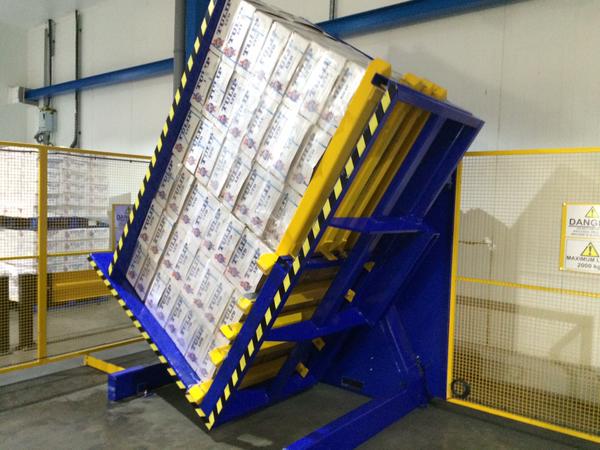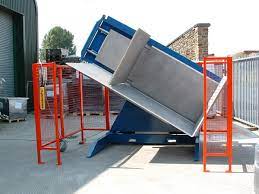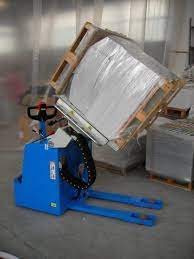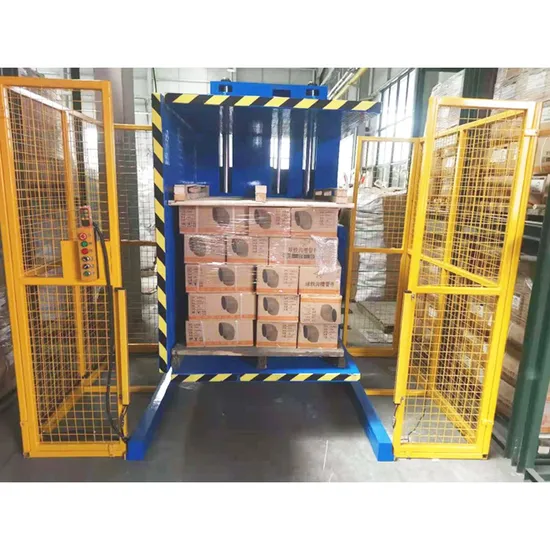How Pallet Inverters Solve Challenges for CE-Certified Machines in Food-Grade Operations in Spain
Are you running a food processing operation in Spain? If so, you know the daily pressure. You must meet strict hygiene standards. You must also comply with complex CE regulations. A common headache is dealing with incoming pallets. Wooden pallets arrive from outside suppliers. They can carry dust, pests, or bacteria. Bringing them into your clean production area is a huge risk. This can lead to product contamination, failed audits, and major operational delays. Imagine the cost and damage to your brand from a product recall caused by a simple wooden pallet. Manually transferring goods to clean pallets is slow, puts your workers at risk of injury, and is highly inefficient. There is a better way. A CE-certified pallet inverter offers a simple, automated solution. It allows you to switch loads to clean, in-house pallets safely and efficiently, ensuring you meet all compliance rules.
A pallet inverter solves these challenges in Spanish food-grade operations by providing a controlled, automated system to transfer goods from external pallets to hygienic, food-safe pallets. This is critical for meeting the stringent CE certification standards, which demand specific material, design, and safety features. By isolating outside pallets, these machines prevent contamination, protect product integrity, and ensure the safety of your operators, making them essential for compliance.

This solution seems straightforward, but the details matter. What does "CE-certified" truly mean for a machine in a Spanish food factory? It is much more than a simple sticker on the side of the equipment. It represents a deep commitment to safety and quality. Let's explore the specific requirements. We will see how a pallet inverter is engineered from the ground up to meet these demanding standards. This knowledge will help you make a more informed investment for your facility.
What are the specific CE certification requirements for pallet inverters in the Spanish food industry?
Navigating the world of CE regulations can feel like trying to solve a difficult puzzle. You know compliance is mandatory. But understanding the specific directives and standards for your equipment is complex. You worry about making a mistake. A wrong choice could mean buying a non-compliant machine. This can lead to project delays, unexpected costs, and major headaches with regulators. The key is to understand the main CE directives that apply to pallet inverters. This clarity allows you to ask suppliers the right questions and ensure your investment is sound from day one.
The primary CE certification requirements for pallet inverters in the Spanish food industry come from several EU Directives. These include the Machinery Directive (2006/42/EC) for operational safety, the Low Voltage Directive (2014/35/EU) for electrical systems, and the EMC Directive (2014/30/EU) for electromagnetic compatibility. Furthermore, any parts that might touch the product must comply with Regulation (EC) No 1935/2004 for food contact materials.

Dive Deeper: Deconstructing CE Compliance
Understanding these regulations is the first step toward choosing the right machine. It’s not just about ticking a box; it’s about ensuring the long-term safety and viability of your operations. In my years of designing and building industrial machinery, I’ve learned that a solid foundation in these principles is non-negotiable. The standards for the steel industry are tough, and that experience taught me to build for reliability and safety above all else. These same principles apply directly to the food industry, where the stakes are just as high.
The Machinery Directive (2006/42/EC): The Heart of Safety
This is the most important directive for any machine with moving parts. It requires a thorough risk assessment for every possible stage of the machine's life, from installation to maintenance and decommissioning. For a pallet inverter, this means features like interlocking safety gates are mandatory. If a gate is opened during operation, the machine must stop immediately. Light curtains are another critical feature. They create an invisible barrier of light; if broken by an operator, the machine halts. Emergency stop buttons must be clearly visible and easily accessible from all operator positions. The control system itself, often a PLC, must be designed to be fail-safe. This ensures that a component failure does not lead to a dangerous situation.
Food Contact Materials & Hygienic Design
Regulation (EC) No 1935/2004 is clear: materials cannot transfer their constituents to food in quantities that could endanger human health. For a pallet inverter, this primarily affects the clamping plates or surfaces that touch the product packaging. This is why stainless steel is the standard. Painted surfaces are unacceptable because paint can chip and fall into the product. Beyond the specific regulation, Good Manufacturing Practices (GMP) demand a hygienic design. This means the machine must be easy to clean. We achieve this with smooth, polished welds, rounded corners, and the elimination of crevices or hollow sections where water and bacteria can accumulate.
Here is a simple breakdown of the key directives:
| Directive/Regulation | Key Requirement for Pallet Inverters | Why It Matters for Spanish Food Ops |
|---|---|---|
| Machinery Directive 2006/42/EC | Comprehensive risk assessment, interlocking guards, certified E-stops | Prevents serious operator injuries and is the legal basis for the CE mark on machinery. |
| Regulation (EC) 1935/2004 | Use of food-grade materials (e.g., Stainless Steel 304/316) | Prevents chemical leaching and contamination of food products, ensuring consumer safety. |
| Good Manufacturing Practice (GMP) | Easy-to-clean design, no crevices, sloped surfaces | Minimizes harborage points for bacteria, simplifies sanitation, and reduces cleaning time. |
| Low Voltage Directive 2014/35/EU | Safe electrical components, proper insulation, and grounding | Protects staff from the risk of electrical shock during operation and maintenance. |
| EMC Directive 2014/30/EU | Must not emit disruptive electromagnetic interference | Ensures the pallet inverter does not interfere with other sensitive electronic equipment in the plant. |
How do pallet inverters enhance hygiene and safety in food-grade operations?
Think of your clean production area as a fortress. You work hard to protect it from outside contaminants. But every time a truck delivers goods on an external wooden pallet, your fortress is under threat. These pallets can carry dust, moisture, insects, and harmful bacteria. A single contaminated pallet can compromise an entire batch of product, leading to enormous waste and financial loss. At the same time, asking your team to manually restack heavy loads from one pallet to another is a recipe for back injuries and strains. A pallet inverter acts as the perfect gatekeeper. It creates a secure checkpoint to transfer your goods onto clean, sanitized pallets, protecting both your products and your people.
Pallet inverters fundamentally enhance hygiene by creating a physical barrier between external "dirty" receiving areas and internal "clean" production zones. They enable the complete removal of outside pallets, which are common sources of contamination, and allow goods to be transferred to sanitized, food-safe pallets. From a safety perspective, they automate the strenuous and awkward task of load transfer, dramatically reducing the risk of musculoskeletal injuries linked to manual handling.

Dive Deeper: A Gateway to Purity and Protection
The real-world impact of a pallet inverter goes far beyond its mechanical function. It transforms a critical control point in your facility from a high-risk area into a streamlined, safe, and efficient process. I’ve seen this transformation firsthand in many factories. Before, the receiving dock was a chaotic space. Now, it’s an orderly transition zone.
Creating a Hygienic Airlock
The workflow is simple and effective. A forklift brings a pallet of raw materials, often on a cheap wooden pallet, to the "dirty" side of the pallet inverter. The operator initiates the cycle. The machine's clamping platforms secure the load from the top and bottom. The inverter then rotates the entire load, typically 180 degrees. The original wooden pallet is now on top. The machine opens, and the wooden pallet is removed by the forklift. A clean, sanitized plastic or stainless steel pallet is placed on the load. The machine then rotates back, and the product, now on a clean pallet, exits into the "clean" side of your production facility. The contaminated wooden pallet never crosses the threshold. This simple process creates a powerful barrier, isolating your clean environment from external risks.
Eliminating Contamination Vectors
Wooden pallets are a significant problem in hygienic environments. They are porous, so they absorb moisture, which encourages mold and bacterial growth. They can have splinters, which can puncture packaging. They are often treated with chemicals under ISPM 15 regulations for international shipping, and you don't want those chemicals near your food products. Finally, they can harbor insects. A food-grade pallet inverter allows you to completely eliminate these vectors. By transferring goods to non-porous, easily sanitized plastic or stainless steel pallets, you take control of hygiene at the earliest possible point. This is a proactive step that is far more effective than any reactive cleaning process later in the line.
Protecting Your Most Valuable Asset: Your People
Safety is just as important as hygiene. Manual restacking of goods is one of the leading causes of workplace injuries in warehousing and manufacturing. A typical pallet load can weigh over 1,000 kg. Asking employees to bend, lift, and twist while moving heavy boxes or bags all day is unsustainable. It leads to back injuries, shoulder strains, and other musculoskeletal disorders. These injuries result in lost workdays, increased insurance costs, and lower morale. A pallet inverter automates this entire process. It does all the heavy lifting. The operator simply uses a forklift or pushes a button. I remember visiting a factory where a near-miss occurred during a manual transfer. It was a stark reminder that investing in safety automation isn't a cost; it's a fundamental responsibility.
What are the key design features of a CE-certified, food-grade pallet inverter?
You have decided you need a food-grade pallet inverter. But when you start looking, you realize not all machines are the same. How do you know what to look for? Choosing a machine that only looks good on paper is a big risk. You could end up with a machine that is difficult to clean, starts to rust prematurely, or doesn't truly meet hygiene standards, even if it has a CE sticker. The solution is to focus on the specific design features. By understanding the materials, construction methods, and cleanability, you can invest with confidence in a machine truly built for the tough demands of the food industry.
The essential design features of a CE-certified, food-grade pallet inverter include full construction from stainless steel, typically Grade 304 or 316, for corrosion resistance and cleanability. It must have a "wash-down" rated design, meaning motors, sensors, and electrical cabinets are sealed to at least an IP65 rating. Critically, the construction must be hygienic, avoiding hollow frames or crevices where bacteria can hide, and featuring smooth, polished welds and rounded corners to make sanitation fast and effective.

Dive Deeper: Engineering for Cleanliness and Durability
As an engineer, the details of construction are what I find most important. A machine can have all the right certifications, but if it is not built correctly, it will fail in a demanding environment. In the food industry, a machine is constantly exposed to water, cleaning chemicals, and varying temperatures. The design must account for this reality.
Material Selection: Stainless Steel is Non-Negotiable
For food operations in Spain and across the EU, stainless steel is the gold standard. Painted mild steel is not an option. The paint will inevitably chip or peel under high-pressure washing, creating a physical contamination risk.
- Stainless Steel 304: This is the workhorse for most food applications. It offers excellent corrosion resistance to a wide variety of cleaning agents and food products. It's ideal for dry goods, baked goods, and general processing.
- Stainless Steel 316: This grade contains molybdenum, which gives it superior resistance to chlorides and acids. If your operation handles products with high salt content (like cured meats or cheese), acidic products (like tomatoes, citrus, or vinegar), or uses chlorine-based sanitizers, the extra investment in 316 stainless is wise. It prevents pitting and corrosion, extending the life of the machine significantly.
Construction for Ultimate Cleanability
A hygienic design is about what you don't see. It's about eliminating places for bacteria to hide.
- No Hollow Sections: Hollow square tubing is cheaper to build with, but it's a major hygiene risk. If a seal fails, water and bacteria can get inside and become impossible to clean out. Food-grade machines should use solid bars or fully sealed, welded tubing.
- Continuous, Polished Welds: Every weld seam should be continuous, not "stitch" welded. After welding, the seams must be ground smooth and polished. This eliminates the tiny pits and crevices in a raw weld where food particles and bacteria can get trapped.
- Sloped Surfaces: Any horizontal surface is a place for water to pool. A good design incorporates sloped surfaces and an open-frame construction, so water from cleaning runs off completely and the machine dries quickly.
Wash-down Capability: Understanding IP Ratings
The IP (Ingress Protection) rating tells you how well an electrical enclosure is sealed against dust and water. In a food plant, this is critical.
- IP65: This means the electrical components are protected against low-pressure water jets from any direction. This is the minimum acceptable rating for a wash-down area.
- IP67: This offers even more protection, allowing for temporary immersion in water. This rating is often specified for components in very wet areas.
All motors, sensors, junction boxes, and control panels must meet these standards to withstand daily sanitation routines.
| Feature | Standard Industrial Option | Essential Food-Grade Upgrade | Why it's Critical for Spanish Food Ops |
|---|---|---|---|
| Material | Painted Mild Steel | Stainless Steel 304/316 | Resists corrosion from water, acidic foods, and strong cleaning chemicals. |
| Construction | Bolted frame, hollow tubes | Fully welded, polished seams, open-frame | Prevents bacterial buildup in hidden areas and simplifies thorough cleaning. |
| Electronics | Standard Enclosure (IP54) | Wash-down Rated Enclosures (IP65+) | Withstands daily high-pressure washing and sanitation without failure. |
| Components | Standard bearings, hydraulic oil | Sealed bearings, food-grade lubricant/oil | Prevents contamination of the product from machine components themselves. |
How can pallet inverters integrate with existing food processing lines in Spain?
Buying a new piece of equipment is one step. But the real test is making it work smoothly with your existing production line. A standalone machine that requires constant manual intervention can create a new bottleneck. If your new pallet inverter can't communicate with your conveyors and factory control systems, you are just trading one inefficient manual process for another. You won't get the full benefit of your investment. Fortunately, modern pallet inverters are not standalone islands. They are designed for seamless physical and digital integration, allowing them to become a smooth, automated, and intelligent part of your entire workflow.
Pallet inverters integrate with existing food processing lines in Spain through two primary methods. Physically, they connect via automated roller or chain conveyors, creating a hands-free system for loading and unloading pallets. Digitally, their PLC (Programmable Logic Controller) is programmed to communicate with the plant's central control system or MES (Manufacturing Execution System). This enables synchronized operation, automatic data collection, and streamlined fault reporting, turning the machine into an active part of the production line.

Dive Deeper: From Standalone Machine to Integrated System
When I started my journey in this industry, machines often worked in isolation. Today, connectivity is everything. A machine's value increases dramatically when it can share information and work in concert with other systems. This is especially true for a machine like a pallet inverter, which sits at the critical junction between receiving and production.
Physical Integration: The Flow of Materials
How the machine fits into your plant's layout is the first consideration. A good supplier will work with you to plan this, not just sell you a machine.
- Standalone: The simplest setup. A forklift loads a pallet, the machine operates, and a forklift removes the new pallet. This is great for lower-throughput operations or when the machine is located away from the main production line.
- Semi-Automated: This is a very common and effective setup. An infeed conveyor brings the pallet to the inverter automatically. After the exchange cycle, a forklift removes the load on the new pallet. This eliminates the forklift movement on the "dirty" side from having to enter the clean zone.
- Fully Automated: For high-throughput operations, this is the ultimate solution. Conveyors feed the pallet in, and another set of conveyors automatically takes the load on the new pallet away to the next stage (e.g., a wrapper or a staging area). This requires careful planning but delivers maximum efficiency and minimal labor. I remember helping a client in the Valencia region, a large citrus fruit exporter, design a fully automated system. It completely solved their receiving bottleneck and seamlessly connected their raw material intake with their sorting and packing lines.
Control System Integration: Teaching Machines to Talk
For any level of automation, the control systems must communicate. The pallet inverter has its own PLC (Programmable Logic Controller), which is its brain. This brain needs to talk to your main factory PLC or MES.
- PLCs: Most European factories, including those in Spain, use controllers from brands like Siemens or Allen-Bradley (Rockwell Automation). A good machine supplier can provide the inverter with a PLC from the brand you prefer, making it easier for your maintenance team to support.
- Communication Protocols: The PLCs talk to each other using a specific language, or protocol. Common industrial protocols include PROFINET or EtherNet/IP. Before you buy, you must confirm that the inverter's PLC can speak the same language as your existing factory systems. This allows for simple commands like "start cycle," "cycle complete," or "machine fault."
This integration turns the pallet inverter into a smart device on your network. It can tell other systems when it's ready for a new pallet or when a load is ready to be picked up, keeping the entire line moving smoothly.
My Insights: Beyond Compliance - The Real Value of Food-Grade Pallet Inverters
Throughout my career, from an engineer on the factory floor to establishing my own company, I've learned one crucial lesson: the best investments are the ones that solve more than one problem. When we talk about a CE-certified, food-grade pallet inverter for an operation in Spain, it's easy to get focused on compliance. Meeting the Machinery Directive and hygiene regulations is essential. It's the ticket you need to even be in the game. But a CE mark is just the beginning. It's the minimum requirement. The real, lasting value of this equipment goes far beyond simply avoiding a fine from an inspector.
When you look at a machine, don't just ask, "Is it compliant?" Ask, "What does this enable?" For a forward-thinking leader like a plant manager or owner, this is the most important question. A pallet inverter isn't just a piece of metal that turns things over. It's a strategic tool.
First, it protects your brand. In the food industry, your reputation is everything. A single product recall due to contamination can destroy years of trust you've built with your customers. The cost of a recall—in lost product, logistics, and damaged reputation—can be crippling. A pallet inverter is a powerful insurance policy against this, and you can't put a price on that peace of mind.
Second, it turns a cost center into a source of efficiency. Manual labor for transferring pallets is a direct cost. Injuries from that labor are a direct cost. Damaged product from clumsy manual handling is a direct cost. The pallet inverter attacks all three of these. It reduces labor needs, it drastically cuts the risk of injury, and it handles products smoothly and safely. This directly improves your operational efficiency and lowers your cost per unit. It helps you achieve the goal of reducing overall operating costs, not by cutting corners, but by working smarter.
Finally, choosing the right machine is about finding a partner, not just a supplier. When I started my factory, I needed people who understood my goals, who could help me plan my layout, and who would be there to support the equipment long after the sale. That is the philosophy behind SHJLPACK. We want to share our knowledge to help you find the right solution. A pallet inverter is an investment in the future of your factory. It prepares you for even stricter hygiene standards and the push for greater automation. It's not just about solving today's compliance problem; it's about building a more robust, efficient, and profitable operation for tomorrow.
Conclusion
A CE-certified pallet inverter is more than a compliance tool; it's a strategic investment in the hygiene, safety, and efficiency that defines a modern Spanish food operation.



